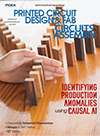News
The net loss was SEK 55.1 million, down from a loss of SEK 11.1 million a year ago.
Including the electronics manufacturing firm's discontinued telecom operations, sales fell 17%.
The operating loss increased to SEK 52.5 million, from a loss of 8.6 million last year, including structural and other nonrecurring costs of SEK 44 million. The operating margin was -19.2%, down from -2.6%.
During the quarter, Note began to shutter production at its plants in Skänninge, Sweden, and Tauragé, Lithuania, and took restructuring costs of SEK 40 million. The closures should save the firm SEK 50 million.
Also, new contracts were signed with Axell Wireless and Hernis.
Ed.: 1 SEK = 0.138551 US$
VELLINGE, SWEDEN -- Top 40 EMS firm PartnerTech reported first-quarter net sales of SEK 557.4 million ($77.2 million), down 6.2% from a year ago.
SAN JOSE -- Sanmina-SCI has signed a definitive agreement to acquire fellow EMS firm BreconRidge in a deal valued at $53 million, including equity and the assumption of certain liabilities. The acquisition would extend the top tier EMS firm's reach into RF and optoelectronic manufacturing.
BANNOCKBURN, IL – March North American PWB shipments were up 17.7% year-over-year, while orders rose 36.8% compared to 2009.
Year to date, shipments were up 8.3%, and orders were up 29.9%, said IPC today. Sequentially, March shipments increased 23.8%, and orders rose 31.6%.
The book-to-bill ratio increased to 1.09. A ratio of more than 1.0 suggests current demand is ahead of supply, which is a positive indicator for sales growth over the next two to three months.
For the month, rigid shipments were up 19.6 %, while orders increased 38.4% year-over-year.
Year to date, rigid shipments were up 9.2%, and orders grew 31.9% compared the same period last year. Sequentially, rigid shipments increased 23.5 % and orders rose 28.2%. The rigid book-to-bill ratio grew to 1.10.
Flex circuit shipments in March were down 1.3%, but orders were up 18.9% year-over-year.
Year to date, flex shipments were down 2.4%, and orders were up 7.1%. Sequentially, flex shipments went up 27.3%, while orders grew 98.8%. The flex book-to-bill ratio improved to 0.98.
Rigid PWBs represent an estimated 90% of the current North American industry. In March, 85% of total shipments reported were domestically produced. Domestic production accounted for 85% rigid PWB and 80% of flex circuit shipments.
HALFMOON, NY – Precision Valve & Automation Inc. issued a cease and desist letter to Specialty Coating Systems of Indianapolis, citing 33 potential infractions of PVA’s two patents.
BANNOCKBURN, IL – Political strategist Charles Black, Jr., and US Rep. Maurice Hinchey (D-NY) will speak at IPC’s Capitol Hill Day.
Black will provide an update on the political climate in Washington. Rep. Hinchey will discuss support for electronics interconnect companies, and provide information about how relationships can be built with elected officials.
The event will take place June 9 and 10, and will focus on influencing legislators on issues critical to industry competitiveness.
Also on tap:
• Brian Fitzgerald, a partner at the lobbying and law firm of PCT Government Relations, will provide a briefing on government support for R & D tax credits.
• Mikel Williams, president and CEO, DDi Corp., will provide a briefing about the issue of congressional funding for the DoD PCB executive agent, which affects the ability of the US electronic interconnect supply chain to meet future needs.
• Dormant bills in Congress such as the Employee Free Choice Act and Card Check are resurfacing. Glenn Spencer, executive director of the Workforce Freedom Initiative at the US Chamber of Commerce, will discuss potential effects of Card Check legislation, which would rewrite US labor laws.
• Also, Chris Fish, VP of McAllister & Quinn, will share pointers on how to lobby effectively.
The metals conglomerate said first-half revenues would be 25% to 27% higher than last year. It forecast earnings of 110 million and 115 million pounds, up from 17 million pounds in 2009.
Cookson said the electronics market outlook for the second half also was strong.
SCOTTSDALE, AZ -- The High Density Packaging User Group has updated its landmark 2004 Pb-free guideline on issues faced by manufacturers of high-reliability electronics.
MINNEAPOLIS -- HEI Inc. today reported first-quarter net sales rose 7.2% to $9.52 million.
Press Releases
- Pushed by glass core and high-end ICs substrates for AI, the advanced IC substrate market reaches $31 billion by 2030
- Pushed by glass core and high-end ICs substrates for AI, the advanced IC substrate market reaches $31 billion by 2030
- Ryder Vietnam - Phase 2: Building resilience and meeting demand
- Scanfil and Etteplan deepen their strategic partnership into production testing


